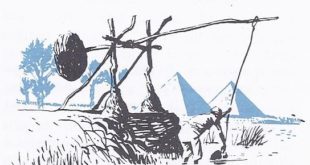Now Hiram, King of Tyre, sent his servants to Solomon, when he heard that they had anointed him King. . . And Solomon sent word to Hiram, “ . . . I purpose to build a house for the name of the Lord my God. . . Now therefore command that cedars of Lebanon be cut for me; and . . . I will pay you for your servants such wages as you set; for you know that there is no one among us who knows how to cut timber like the Sidonians [people of the city of Sidon].” . . . And Hiram sent to Solomon, saying, “. . . I am ready to do all you desire in the matter of cedar and cypress timber. My servants shall bring it down to the sea from Lebanon; and I will make it into rafts to go by sea to the place you direct and I will have them broken up there, and you shall receive it; and you shall meet my wishes by providing food for my household.” So Hiram supplied Solomon with all the timber of cedar and cypress that he desired. while Solomon gave Hiram twenty thousand cors [measures] of wheat as food for his household and twenty thousand cors of beaten oil. . . And there was peace between Hiram and Solomon; and the two of them made a treaty. And King Solomon built a fleet of ships. . . And Hiram sent with the fleet his servants, seamen who were familiar with the sea. . . These words adapted from the Bible tell the story of trade agreements between two kings who ruled about 1000 B.C. You have probably heard of Solomon. He had the reputation of being the wisest king of ancient times. But …
Read More »The Growth of Egyptian and Mesopotamian Civilization
People satisfy their important needs in different ways. For example, most of you obtain water merely by turning on a faucet in your home. The water is pumped from large reservoirs and piped considerable distances before reaching your home. Many however, get water from wells. The water is raised in a variety of ways — by pumps operated by hand, by windmills, by gasoline engines, or by electric motors. In earlier times the well sweep, or pole with a bucket at one end, was often used. If you should travel along Egypt’s Nile River today, you might see a farmer on the bank dipping up water with a bucket attached to a long pole. The pole rests on an upright support. At the Opposite end of the pole there is a heavy weight which balances the water-filled scoop. This device, which is called a shadoof, is like the American well sweep. It helps the farmer to raise his filled bucket and to empty it into an irrigation ditch that is above the river level. Egyptian farmers are thus able to irrigate fields that otherwise would be baked hard and dry under Egypt’s intense sun. The shadoof has been in use for more than 5000 years. Egyptians today have more efficient methods for irrigating their fields, but the shadoof has not completely disappeared. It is a link between Egypt today and Egypt in ancient times. The Nile is not the only great river where you could see reminders of the long ago. On the muddy Tigris River, beside the great city of Baghdad in Iraq, you might see men floating along in great round watertight baskets used as boats. These boats, called gufas, have been in use for thousands of years. There are other, more impressive links with the distant past …
Read More »Man’s Long Road Up From Savagery
Perhaps you have asked yourself, “What would I have done?” as you have read an adventure yarn or the true story of some person set down in a wild and remote spot. One of the most famous stories in the English language recounts the adventures of’ Robinson Crusoe, who was shipwrecked and cast ashore on an uninhabited island. Crusoe was completely alone and had only the few materials which he saved from the wreckage. With these and with what he found on the island, Crusoe had to provide his own food and shelter. Days and even weeks were required to fashion the simplest tools and furniture. Just to keep alive was a constant struggle. If you stop to think of it, Robinson Crusoe possessed tremendous advantages over the men who first inhabited this earth in the dim and distant past. He, atleast, had some equipment with which to work. More important, he had thousands of years of man’s experience on which to draw. In contrast, the earliest men had none of these advantages. They did not know how to use fire, how to build the simplest of shelters, or how to fashion the crudest of tools. They had no good means of communicating with one another. They did not even know that by planting seeds they could grow food. How did early peoples get the experience and develop the skills needed for civilized living? The big questions are, 1. What was the earth like before men lived on it? 2. How did men live during the Old Stone Age? 3. What great advances were made by people in the New Stone Age? 4. How did ways of living improve in the Bronze Age? To answer these questions. 1. What Was the Earth like Before Men Lived on It? Our world …
Read More »


